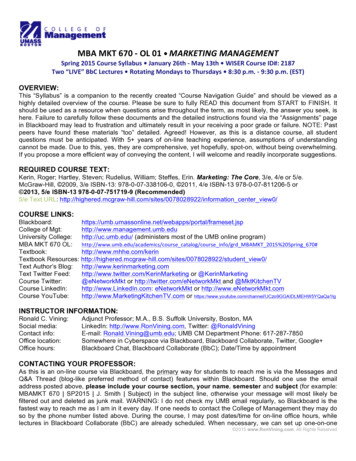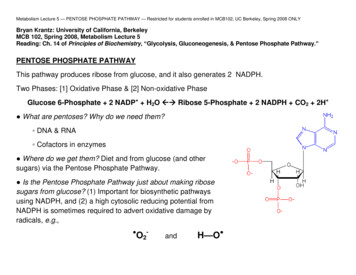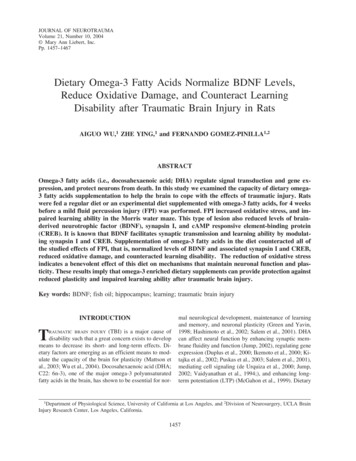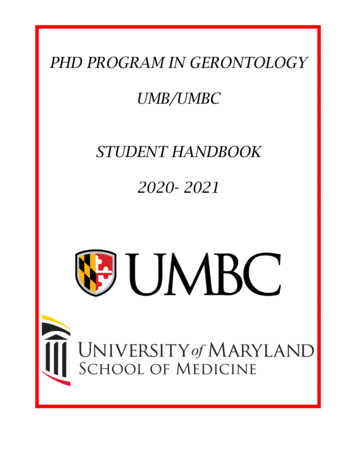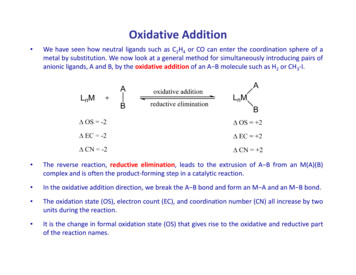
Transcription
Oxidative Addition We have seen how neutral ligands such as C2H4 or CO can enter the coordination sphere of ametal by substitution. We now look at a general method for simultaneously introducing pairs ofanionic ligands, A and B, by the oxidative addition of an A B molecule such as H2 or CH3‐I. The reverse reaction, reductive elimination, leads to the extrusion of A B from an M(A)(B)complex and is often the product‐forming step in a catalytic reaction. In the oxidative addition direction, we break the AA BB bond and form an MM AA and an MM BB bond. The oxidation state (OS), electron count (EC), and coordination number (CN) all increase by twounits during the reaction. It is the change in formal oxidation state (OS) that gives rise to the oxidative and reductive partof the reaction names.
Oxidative additions proceed by a great variety of mechanisms,mechanisms however,however a vacant 2esite is always required on the metal. We can either start with a 16e complex or a 2e site must be opened up in an 18ecomplex by the loss of a ligand producing a 16e intermediate species. The change in oxidation state means that the starting metal complex of a givenoxidation state must also have a stable oxidation state two units higher to undergooxidative addition (and vice versa for reductive elimination).
Binuclear oxidative addition Each of two metals change their oxidation states, electron count, and coordination number byone unit each.A2LnM oxidative additionLnMA LnMBLnMA LnMBBALnMMLn oxidativeid ti additiondditiBOS 1EC 1CN 1 This typically occurs in the case of a 17e complex or a binuclear 18e complex with an M Mbond where the metal has a stable oxidation state more positive by one unit. f off two electrons into the σ כ orbital of theWhatever the mechanism, there is a net transferA B bond, and the two A B σ electrons are divided between both metals. This cleaves the A B bond and makes an M A and an M B bond.
-L, X2
As we have seen, oxidative addition is the inverse of reductive elimination and vice versa. IIn principle,i i l thesethreactionstiare reversible,ibl bbutt iin practiceti ththey ttendd tto go iin ththe oxidativeid ti orreductive direction only.The position of equilibrium in any particular case is governed by the overall thermodynamicsRelative stabilities of the two oxidation statesgBalance of the A B vs. the M A and M B bond strengths Alkyl hydride complexes commonly undergo reductive elimination of an alkane, but rarelydoes oxidative addition of alkanes occur.occur Conversely, alkyl halides commonly undergo oxidative addition, but the adducts rarelyreductively eliminate the alkyl halide. Rare examplese amples of eqequilibriumilibri m do eexist,ist bbutt are thermodthermodynamicallynamicall controlledcontrolled:
Oxidative addition is usually favored by strongly donating ligands because these stabilize theincreased oxidation state of the central metal. While the change in formal oxidation state is always 2 (apart from binuclear oxidativeaddition) , the real charge on the metal changes much less because ligands A and B do notend up with pure 1 charges in LnM(A)(B) – electroneutrality principle ! The reall changeThhi chargeinhatt theth metalt l andd ligandslid dependsdd mostlytl on thethelectronegativity of A and B so that the following reagents are more oxidizing in the order:H2 HCl Cl2. We can estimate the oxidizing power of different reagents experimentally by measuringν(CO) on going from IrCl(CO)L2 to Ir(A)(B)Cl(CO)L2 because a more oxidizing reagent willreduce M CO back bonding.OCClLLIr ABLOCClIrBLA
Oxidative additions are very diverse mechanistically, and we therefore considereach type separately.1. Concerted, or three‐center, oxidative addition mechanism2. SN2 mechanism3. Radical mechanisms4. Ionic Mechanisms
1. Concerted Mechanism Concerted, or three‐center, oxidative addition is really an associative reaction in which theincoming ligand first binds as a σ complex and then undergoes bond breaking as a result ofstrongg back donation from the metal into the σ כ orbital. Non‐polar reagents, such as H2, or compounds containing C H and Si H bonds all tend toreact via a σ complex transition state (or even an intermediate) of this type. The associative step a involves formation of a σ complex; sometimes this is stable and thereaction stops here. Step b is the oxidative part of the reaction in which metal electrons are formally transferredto the σ כ orbital of A B.
There are many examples, however, one of the most‐studied cases is the addition of H2 to the16e square planar d8 species IrCl(CO)(PPh3)2 [aka Vaska’s complex ] to give the 18e d6octahedral dihydride IrCl(H2)(CO)(PPh3)2 . Normally two ligands that are trans in the Ir(I) complex fold back to give the cis dihydrideisomer butisomer,b t subsequents bseq ent rearrangement can occur.occ r Conversely, in a reductive elimination such as the loss of H2 from the dihydride, the two ligandsto be eliminated normally have to be cis to one another.(consider the reverse of the reaction above)
The C H and Si H bonds of various hydrocarbons and silanes can also oxidativelyadd to metals.metals Among different types of C H bonds, those of arenes are particularly prone tooxidative addition because of the high thermodynamic stability of the aryl hydrideadduct.adduct Agostic complexes, σ complexes of C H bonds, can be thought of as lying along thepathway for oxidative addition but arrested at different points. A study of the structures of a series of these complexes allowed the kineticpathway and reaction trajectories to be mapped out. The C H bond seems to approach with the H atom pointing toward the metal. The C H bond then pivots around the hydrogen to bring the carbon closer tothe metal in a side‐on arrangement, followed by C H bond cleavage.
Crabtree et al. Inorg. Chem. 1985, 24, 1986‐1992
Carbon–carbon bonds do not normally oxidatively add, but a classic early case, thereaction of cyclopropane with Pt(II) to give a Pt(IV) metalacyclobutane shownbelow, illustrates how the reaction can be driven by ring strain. Similarly, biphenylene readily reacts in the same way.
Upon addition of O2, Ir(I) reduces the O2 to O22 , the peroxide ion, which coordinates to theIr(III). g the reaction as a ligandgaddition byy regardinggg O2 as a 2e donor such asWhyy not envisageethylene? This is a result of the different formal oxidation states assigned to the L and X2 extreme picturesof binding. In fact, ethylene is much closer to the L extreme while O2 is very close to the X2 extreme. This means that the conventional descriptions of ethylene binding as a ligand addition and of O2binding as an oxidative addition are the most appropriate. For ligands, such as CF2 CH2, which bind in a fashion that is approximately equidistant betweenthe two extremes, there is a gray area in which the choice between the two descriptions isarbitrary. This emphasizes that categories such as “oxidative addition” are mental constructs and havetheir limitations.
2. SN2 Mechanism (non‐concerted) In all oxidative additions, a pair of electrons from the metal is used to break the A Bbond in the reagent. In the SN2 pathway, adopted for polarized A‐B substrates such as alkyl halides, themetal electron pair of LnM directly attacks the A–B σ כ orbital by an in‐line attackat the least electronegative atom (where σ כ is largest) formally to give LnM2 , A ,and B fragments (ionic model).model) The SN2 mechanism is often found in the addition of methyl, allyl, acyl, and benzylhalides. Like the concerted type, they are second‐order reactions, but they are acceleratedin polar solvents and show negative entropies of activation ( S). This is consistent with an ordered, polar transition state, as in organic SN2reactions.
Inversion at carbon has been found in suitably substituted halides. The stereochemistry at the carbon of the oxidative addition product wasdetermined by carbonylation to give the metal acyl followed by methanolysis togive the ester.ester Both of these reactions are known to leave the configuration at carbonunchanged, and the configuration of the ester can be determined unambiguouslyffromtheh measuredd opticall rotation off theh finalf l organic product.d
R and X may end up cis or trans to one another in the final product, as expectedfor the recombination of the ion pair formed in the first step.vs. concerted mechanism
Of the two steps, the first involves oxidation by two units but no change in theelectron count (Me is a 0e reagent) The second step involves an increase by 2e in the electron count (I is a 2ereagent) but no change in the oxidation statestate. Only the two steps together constitute the full oxidative addition. When an 18e complex is involved, the first step can therefore proceed withoutthe necessity of losing a ligand first. Only the second step requires a vacant 2e site.
The more nucleophilic the metal, the greater its reactivity in SN2 additions, asillustrated by the reactivity order for some Ni(0) complexes:Ni(PR( 3)4 Ni(PAr( 3)4 Ni(PR( 3)2((alkene)) Ni(PAr( 3)2((alkene)) Ni(cod)( )2 ((R alkyl)y)Steric hindrance at carbon slows the reaction, so we find the reactivity order:Me‐I Et‐I iPr‐I A better leaving group accelerates the reaction, which gives rise to the reactivityorder:R‐OSO2(C6H4Me) R‐I R‐Br R‐Cl
3. Radical mechanism Radical mechanisms in oxidative additions were recognized later than the SN2 andthe concerted processes. Theyh can alsol beb photoinitiated.h i ii d A troublesome feature of these reactions is that minor changes in the structure ofthe substrate, the complex, or in impurities present in the reagents of solventscan sometimesib enoughbeh to changehtheh rate, andd even theh predominantd imechanism of a given reaction. Sharp disagreements have turned on questions of repeatability and on what typesoff experimentalil evidenceidshouldh ld beb consideredid d as validlid mechanistich i i criteria.i i For example, the use of radical traps, such as RNO , has been criticized on thegrounds that these may initiate a radical pathway for a reaction that otherwisewouldld havehf llfollowedd a non‐radicaldi l mechanismh i ini theh absenceboff trap.
Two subtypesyp of radical processpare now distinguished:g non‐chain chain The non‐chain variant is believed to operate in the additions of certain alkyl halides,()R‐X,, to Pt(PPh3)3 ((R Me,, Et;; X I;; R PhCH2; X Br).PPh3Ph3Pf astPh3PPtPtPPh3PhCH2Brslow PPh3PPh3Ph3HPPPh3 PhCH2BrPt(0)Pt(0)PtPt(I)BrPh3PCH2PhPtPh3Pf astPh3PPtBrPPh3 PhCHh 2Pt(II)Pt(I)
The key feature is one electron transfer from M to the R‐X σ* orbital to form M and (R‐X) . After X transfer to M , the R radical is liberated. Like the SN2 process,process the radical mechanism is faster the more basic the metalmetal,and the more readily electron transfer takes place, which gives the reactivityorderR‐II RRR‐BrBr R‐ClR Cl Unlike the SN2 process, the reaction is very slow for alkyl tosylates [e.g.,ROSO2(C6H4Me)], and it goes faster as the alkyl radical, R, becomes more stableand so easier to form, giving rise to the order of R group reactivity:3 2 1 Me
The second general kind of reaction is the radical chain. This has been identified in the case of the reaction of Et‐BrEt Br and PhCH2Br with thePMe3 analog of Vaska’s complex, IrCl(CO)(PMe3)2 . A chain process occurs if the radicals formed escape from the solvent cagewithout recombination.recombination Otherwise, a radical initiator, Q , (e.g., a trace of air) may be required to set theprocess going. This can lead to an induction period (a period of dead time beforethe reaction starts).starts) In either case, a metal‐centered radical abstracts X from the halide, to leave thechain carrier R .
Chain termination steps limit the number of cycles possible per R . The alkylThlk l group alwaysllloses any stereochemistryth i t att ththe α carbonb bbecause RR’R’’C is planar at the central carbon. Unlike the non‐chain case, the reactions slow down or stop in the presence ofradicaldi l inhibitors,i hibitsuchh as ththe hihinderedd d phenol,hl 22,6‐di‐t‐butylphenol.6 di t b t l hl These quench the radical R to give R H and the stable, and therefore unreactive,aryloxy radical, ArO . Binuclear oxidative additions, because they involve 1e rather than 2e changes atthe metals, often go via radical mechanisms.
4. Ionic mechanism Hydrogen halides are often largely dissociated in solution, and the anion andproton tend to add to metal complexes in separate steps. Two variants have been recognized.1. In the more common one, the complex is basic enough to protonate, after whichthe anion binds to give the final product. protonation – anionation2 Rarer is the opposite case in which the halide ion attacks first2.first, followed byprotonation of the intermediate. anionation ‐ protonation
In the more common mechanism of protonation followed by anionation, thecomplex is basic enough to protonate, after which the anion binds to give the finalproduct. Thi route isThisi favoredfd byb polar solvents basic ligands a low‐oxidation‐state metal
Like the concerted and SN2 mechanisms the ionic mechanism is second order inrate Protonation is the rate determining step:rate. This can be carried out independently by using an acid with a non‐coordinatinganion. HBF4 andd HPF6 are theth mostt oftenft used.d The anion has insufficient nucleophilicity to carry out the second step, and so theintermediate can be isolated!! This is an example of a general strategy in which a “non‐coordinating” anion isused to isolate reactive cations as stable salts.
Rarer is the case of anionation followed by protonation where the halide ionattacks firstfirst, followed by protonation of the intermediateintermediate. This route is favored by polar solvents electron‐acceptor ligands a net positive charge on the complex Polar solvents encourage both ionic mechanisms – why?
Again this is a second order reaction but now follows a rate dependent upon thecounterion concentration as X addition is the rate limiting step.step Similar to the first type mechanism, this step can be carried out independentlywith LiCl alone. N reactionNoti isi observedbd withith HBF4 alone!l! because the cationic iridium complex is not basic enough to protonate andBF4 is a non‐coordinating anion.
oxidative addition because of the high thermodynamic stability of the aryl hydride adduct. Agostic complexes, σcomplexes of C H bonds, can be thought of as lying along the pathway for oxidative addition but arrested atdifferent points. A study of the structures of a series of these complexes allowed the kinetic

